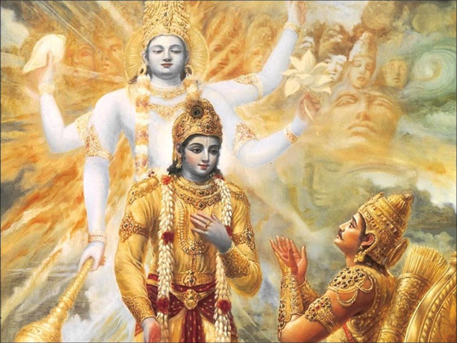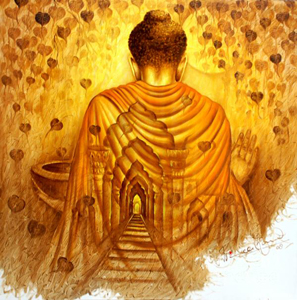Faith is a Cradle of Trees
Author by Nila Bala

When I was in high school, I tried to discover God and ethics through science looking into physics, biochemistry, and neurology. If there was a moral center to ourselves, I wondered, where was it located? But then, I fell off a cliff and stopped wondering as much. I was at an overlook in Peru, and I remember hearing my friend’s voice “Get up; there’s ants all over the bench.” Instead of walking back towards the trail, I walked backwards. And then there was no more walking. My right leg felt nothingness and I fell backwards down the cliff. I felt the way I do in bed, those moments before I fall asleep, perfectly calm with no sense of falling. About ten feet down, a cradle of trees caught me. Mother Bhumi caught me. If I would have fallen a few feet to the left or right, I would be dead. The words of Lord Krishna in the Bhagavad Gita echo in me: “There is a banyan tree which has its roots upward and its branches down, and the Vedic hymns are its leaves. One who knows this tree is the knower of the Vedas.” (Bg 15:1) I had been given the gift of a second chance, another lease on life chances to better know my religion and the Vedas. The moment provided me comfort and brought me closer to my faith, Hinduism.
I have always loved nature I spent my childhood hiking in Yosemite, going to the beach, visiting the red rocks of Sedona, Arizona. But it was when I was nineteen, and spent a summer in the rainforest, that I truly experienced the natural environment. Simultaneously, I began to understand the heart of Hinduism. My japa became my daily walks, starting at 4:30am. The quiet interrupted only by the cries of birds and monkeys calmed my soul. As a result, I came away with a deeper understanding two concepts I hold dear Ahimsa and Karma. Before living in the rainforest, I equated Ahimsa, non-violence, with being a vegetarian, and opposing warfare of any kind. However, I realized that this view was simplistic. So many of our daily actions using electricity, nonrenewable goods, and our transportation mechanisms were hurting Earth at a speed so rapid that our Earth could not recover. For a brief summer, I lived without any modern conveniences and realized how much simpler life could be. I began to coexist and live with creatures that many find repulsive snakes, spiders, mosquitoes, and ticks. They became a daily part of life since our hut was open to the forest meaning all manner of critters could come directly inside our home. We once found a possum in our shower, and realized that the poor creature was ill. He wanted to be in the shower no more than we wanted him there. Realizing this, we released him back into the wild.
 I also vividly remember finding a tick in my scalp one day, gently twisting it out and releasing it. A tourist questioned me as to why I didn’t kill it after all, ticks spread disease and are awful pests. I explained the concept of Ahimsa that the tick was only behaving according to its nature, and that I could decide to respond with compassion or with cruelty. Although I now live with modern conveniences, I have not forgotten the deep and beautiful lessons of the forest, namely the power of responding with nonviolence no matter how the world responds to you. Secondly, the forest taught me the lessons of karma. Lord Krishna tells Prince Arjuna in the Bhagavad Gita, that “For, so sustained by sacrifice, the gods will give you the food of your desire. Who so enjoys their gift, yet gives nothing, and is a thief, no more nor less.” (Bg 3:12). We are all Arjunas being told by our Lord that we must take care of our Earth that provides so much to us. We must give back.
I also vividly remember finding a tick in my scalp one day, gently twisting it out and releasing it. A tourist questioned me as to why I didn’t kill it after all, ticks spread disease and are awful pests. I explained the concept of Ahimsa that the tick was only behaving according to its nature, and that I could decide to respond with compassion or with cruelty. Although I now live with modern conveniences, I have not forgotten the deep and beautiful lessons of the forest, namely the power of responding with nonviolence no matter how the world responds to you. Secondly, the forest taught me the lessons of karma. Lord Krishna tells Prince Arjuna in the Bhagavad Gita, that “For, so sustained by sacrifice, the gods will give you the food of your desire. Who so enjoys their gift, yet gives nothing, and is a thief, no more nor less.” (Bg 3:12). We are all Arjunas being told by our Lord that we must take care of our Earth that provides so much to us. We must give back.
One lesson from the Gita is that there is a natural balance to all things. In order to preserve the balance, it is best to only take what you need. Many people see themselves as separate from the Earth. Hinduism rightfully points out that belief is a fiction. We are one and the same as the Earth, all Brahman. Another lesson here is to be satisfied with enough. It is so easy to want more and more. We are all desperate to fill that hunger within us, that seems ever-growing and never-satisfied. The reality is only moksha can fill that void, not more clothing, cars, food, or other material possessions. Lord Krishna advises us not to grow disillusioned and attached with materials, and to stop accumulating these things that will ultimately never satisfy us. The Earth saved me eight years ago, when it caught be in a cradle of trees as I fell off a cliff. Since that day, the Earth has saved me again, and again. The bedrock of my Hindu faith lies in understanding the immense capacity the Earth has to give to us and our responsibility to give back. It is why my mandir is not only where the idol of Lord Krishna is, but also is a grove of Redwood trees; why my temple is not only made of marble turrets, but of sand dunes and surf. It is why in the Mahabharata, the forest provided a shelter, home, and clothing for the Pandavas. The Earth is our home, and the heart of our Hindu faith.
 One lesson from the Gita is that there is a natural balance to all things. In order to preserve the balance, it is best to only take what you need. Many people see themselves as separate from the Earth. Hinduism rightfully points out that belief is a fiction. We are one and the same as the Earth, all Brahman. Another lesson here is to be satisfied with enough. It is so easy to want more and more. We are all desperate to fill that hunger within us, that seems ever-growing and never-satisfied. The reality is only moksha can fill that void, not more clothing, cars, food, or other material possessions. Lord Krishna advises us not to grow disillusioned and attached with materials, and to stop accumulating these things that will ultimately never satisfy us. The Earth saved me eight years ago, when it caught be in a cradle of trees as I fell off a cliff. Since that day, the Earth has saved me again, and again. The bedrock of my Hindu faith lies in understanding the immense capacity the Earth has to give to us and our responsibility to give back. It is why my mandir is not only where the idol of Lord Krishna is, but also is a grove of Redwood trees; why my temple is not only made of marble turrets, but of sand dunes and surf. It is why in the Mahabharata, the forest provided a shelter, home, and clothing for the Pandavas. The Earth is our home, and the heart of our Hindu faith.
One lesson from the Gita is that there is a natural balance to all things. In order to preserve the balance, it is best to only take what you need. Many people see themselves as separate from the Earth. Hinduism rightfully points out that belief is a fiction. We are one and the same as the Earth, all Brahman. Another lesson here is to be satisfied with enough. It is so easy to want more and more. We are all desperate to fill that hunger within us, that seems ever-growing and never-satisfied. The reality is only moksha can fill that void, not more clothing, cars, food, or other material possessions. Lord Krishna advises us not to grow disillusioned and attached with materials, and to stop accumulating these things that will ultimately never satisfy us. The Earth saved me eight years ago, when it caught be in a cradle of trees as I fell off a cliff. Since that day, the Earth has saved me again, and again. The bedrock of my Hindu faith lies in understanding the immense capacity the Earth has to give to us and our responsibility to give back. It is why my mandir is not only where the idol of Lord Krishna is, but also is a grove of Redwood trees; why my temple is not only made of marble turrets, but of sand dunes and surf. It is why in the Mahabharata, the forest provided a shelter, home, and clothing for the Pandavas. The Earth is our home, and the heart of our Hindu faith.
Biography
Nila Bala is an assistant public defender in Baltimore City and a practicing Hindu. Her faith informs why she does her work, and is at the core of why she works for social justice and the needs of indigent people in her community. She attended college at Stanford University, taught as a preschool teacher, and attended law school at Yale University. She also co-leads Hindu discussion groups in Baltimore through Chinmaya Mission.




























